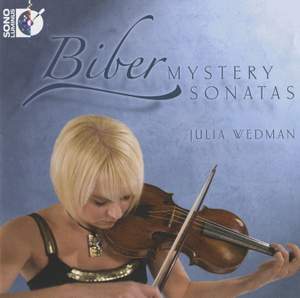Passion, excitement, sorrow, and celebration all fill the room with this new exciting release of Biber: Mystery Sonatas by Julia Wedman. Though the Mystery Sonatas (also called the Rosary Sonatas) weren’t discovered until the late 19th century, these master works of violin virtuosity that employs extensive scordutura (multiple tunings) for the performer have become a favorite of Baroque Music lovers and violinists the world over. After 2 years of research leading up to the recording, Ms. Wedman has brought a new life and impassioned vision to these works.
“Of the violin players of the last century,” wrote the 18th-century historian Charles Burney, “Biber seems to have been the best, and his solos are the most difficult and most fanciful of any music I have seen of the same period.” Over 200 years later, scholars, audiences and performers still agree with him. Heinrich Franz Ignaz Biber, (1644-1704) was one of the most unique violin virtuosi of the late seventeenth-century. While he composed numerous vocal works, including operas, masses and cantatas, he is most notable today for his brilliant instrumental works, specifically solo violin works and chamber music.
Heinrich Biber’s enigmatic sixteen Rosary/Mystery Sonatas have captivated audiences and violinists since they were first discovered in the late 19th century. Biber wrote in his dedication page to the Archbishop Maximilian Gandolph von Khuenberg that he “consecrated these sonatas to the most glorious mysteries which you hold so highly.”
But it is the unique feature of scordatura— the complete re-tuning of the violin—that sets the Rosary/Mystery Sonatas apart. While this practice had been used in violin music before, it is in the Mystery Sonatas that Biber takes this technique to a level that had never been seen before, or ever again. Of the sixteen sonatas in the set, fourteen feature this radical technique. Each new re-tuning of the violin sonically transforms the instrument as the violinist and audience experiences new aural effects. With each sonata, Biber creates in the violin an analogy to the ancient metaphor that the human body itself is a string instrument, resonating with the voice of God.
Originally from Saskatoon, Saskatchewan, Canadian violinist Julia Wedman was invited to join the internationally renowned Tafelmusik Baroque Orchestra (www.tafelmusik.org) in 2005. She quickly developed a reputation for her solo performances with the ensemble and is frequently showcased on Tafelmusik’s recordings as well as their home concert series in Toronto. Julia has played concertos with the group on tours throughout Canada, the U.S.A., Mexico, Puerto Rico, Europe, China and Korea. Julia is a member of the innovative young baroque ensemble I Furiosi (www.ifuriosi.com), whose CD Crazy is also available on Dorian Sono Luminus. She is also one quarter of the Eybler Quartet (www.eyblerquartet.com), a period instrument ensemble that specializes in music of the classical era, and are champions of excellent but underrated composers. As a part of the Aradia Baroque Ensemble and Toronto Camerata under the direction of Kevin Mallon, Julia also recorded many CDs available on Naxos. Ms. Wedman plays a Hendrick Jacobs violin made in Amsterdam in 1694.
This album whose stellar performance is matched with extensive scholarly notes as well as Ms. Wedman’s descriptions of her personal vision for each of the sonatas is the perfect choice for lovers of baroque performance, virtuosic violin music, and a wonderful gift for the Easter season.





